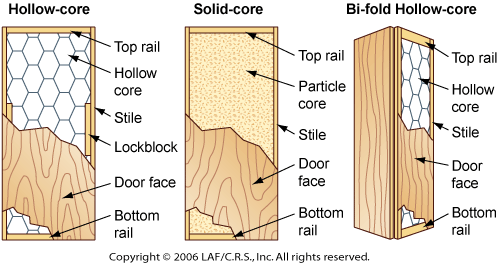The ins and outs of doors
by Leon A. Frechette
The time may come when you'll need to cut a door down in width and/or height to customize the fit to an existing opening, to repair a damaged door, to salvage a door (after an incorrect cut), or to replace a softwood stile with hardwood. It is important to understand the skeleton or framework of a door before altering it for a particular project.
The majority of door blanks are designed with some type of framework
system. The frame of the blank is composed of parts known as "stiles"
and "rails." Stiles (normally softwood) are the vertical pieces
of the door that accept hinges on one side and a handle or deadbolt
on the other. Rails are the horizontal plugs located at the top
and bottom. Some manufacturers allow a minimum 2-1/4" width
for both rails, which gives extra room for trimming the door.
A good point to remember is that a stile always covers the ends
of the rails, top and bottom. The stile is the finished piece
and is visible, especially when the door is open.
The frame is filled with particleboard to create a solid door or
with a double-faced Kraft cellular product (cardboard) in a "honeycomb"
shape for a hollow door. The fill material is called the "core."
Finally, a 3- or 4-ply wood veneer, hardboard, medium-density overlay,
or decorative laminate is glued to both sides of the frame to finish
the door. This is not exactly how a door is manufactured, but it
should give you an idea of the basics.

For other related articles on the subject of doors, click here.
Copyright © 2001 & 2006 LAF/C.R.S., Inc. All rights reserved.
Looking for home improvement Q&As? Click here!
[ Back to Top ]
|


